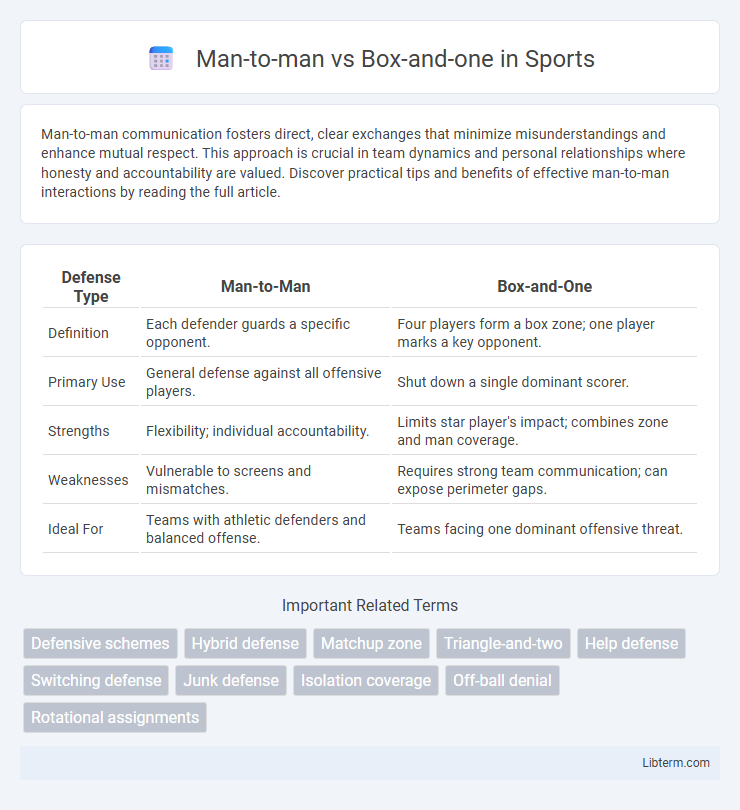Man-to-man communication fosters direct, clear exchanges that minimize misunderstandings and enhance mutual respect. This approach is crucial in team dynamics and personal relationships where honesty and accountability are valued. Discover practical tips and benefits of effective man-to-man interactions by reading the full article.
Table of Comparison
| Defense Type | Man-to-Man | Box-and-One |
|---|---|---|
| Definition | Each defender guards a specific opponent. | Four players form a box zone; one player marks a key opponent. |
| Primary Use | General defense against all offensive players. | Shut down a single dominant scorer. |
| Strengths | Flexibility; individual accountability. | Limits star player's impact; combines zone and man coverage. |
| Weaknesses | Vulnerable to screens and mismatches. | Requires strong team communication; can expose perimeter gaps. |
| Ideal For | Teams with athletic defenders and balanced offense. | Teams facing one dominant offensive threat. |
Understanding Man-to-Man Defense
Man-to-man defense emphasizes individual accountability where each defender is responsible for guarding a specific offensive player, enhancing close coverage and active pressure. This strategy relies on communication and quick reactions to counter ball screens and cuts effectively, preventing easy scoring opportunities. Understanding man-to-man principles is essential for players to anticipate opponents' movements and maintain defensive integrity throughout the game.
What is the Box-and-One Defense?
The box-and-one defense combines a zone defense with man-to-man coverage by positioning four defenders in a box formation around the paint while a fifth defender shadows a key offensive player individually. This strategy aims to neutralize a dominant scorer by applying intense pressure while maintaining zone protection against other players. It is commonly used to disrupt teams reliant on a single offensive threat without compromising overall defensive structure.
Key Principles of Both Defensive Strategies
Man-to-man defense emphasizes individual accountability by assigning each defender to guard a specific offensive player, prioritizing close, physical contact and constant pressure. Box-and-one defense combines elements of zone and man-to-man schemes, featuring four defenders in a box-shaped zone around the key while one player shadows the opponent's primary scorer. Both strategies require effective communication, quick decision-making, and adaptability to counter offensive plays and exploit mismatches.
Strengths of Man-to-Man Defense
Man-to-man defense excels at applying intense pressure on individual offensive players, disrupting their rhythm and limiting scoring opportunities through tight coverage. This defensive strategy allows for quick adjustments and greater accountability as each defender is responsible for a specific opponent, enhancing team communication and cohesion. It creates opportunities for forcing turnovers and contested shots, making it highly effective against teams relying on isolation plays or one-on-one scoring threats.
Advantages of the Box-and-One Approach
The Box-and-One defense offers strategic advantages by combining the strengths of man-to-man and zone defenses, effectively neutralizing an opposing team's star player while maintaining cohesive team coverage. Its hybrid structure creates confusion for the offense, disrupting set plays and isolating key scoring threats. This approach enhances defensive flexibility, allowing quick adjustments against various offensive formations and improving overall defensive efficiency.
Situational Effectiveness: When to Use Each
Man-to-man defense excels in situations requiring tight individual coverage, such as guarding star players or during late-game critical moments where isolation defense is paramount. Box-and-one proves effective against teams with a dominant scorer, combining zone principles to contain overall movement while assigning a single defender to shadow the key threat closely. Choosing between these defenses depends on the opponent's offensive tendencies and situational urgency, with man-to-man favored for balanced team defense and box-and-one ideal for neutralizing one standout player.
Common Weaknesses and Vulnerabilities
Man-to-man defense often struggles against teams with strong off-ball movement and screens, leading to mismatches and defensive breakdowns. Box-and-one defense can be vulnerable to effective ball movement, which exploits the static four-player zone and isolates the single defender in one-on-one situations. Both strategies may exhibit weaknesses in perimeter shooting defense and quick offensive penetration due to their structural limitations.
Famous Basketball Games Featuring Both Defenses
Famous basketball games featuring man-to-man and box-and-one defenses include the 1992 Olympic basketball final, where the USA Dream Team utilized man-to-man defense to counter the unified team, while college basketball classics like the 1985 NCAA Championship showcased the strategic implementation of box-and-one to neutralize dominant scorers. The 2007 NBA Finals also highlighted man-to-man defense by the San Antonio Spurs, contrasted by the Cleveland Cavaliers' use of box-and-one formations to contain Tim Duncan. These games exemplify how coaches leverage both defenses to disrupt opponents' offensive rhythm and maximize team strengths.
Adapting Defensive Strategies for Youth Teams
Man-to-man defense enhances individual accountability and helps youth players develop fundamental defensive skills by closely guarding assigned opponents. Box-and-one defense combines a box-shaped zone with a single player shadowing the opponent's best scorer, effectively disrupting offensive flow while providing team support. Adapting between these strategies fosters versatility in young athletes, promoting court awareness and team communication essential for competitive play.
Expert Tips for Coaches: Choosing the Right Defense
Man-to-man defense enhances individual accountability and allows coaches to leverage player-specific strengths against key opponents. Box-and-one combines zone principles with targeted man coverage, optimizing containment of elite scorers while protecting the paint. Coaches should assess opponent lineup versatility and player matchups to select the defense that maximizes team perimeter pressure and interior control.
Man-to-man Infographic

 libterm.com
libterm.com